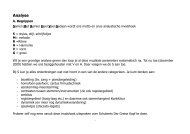Anton Webern and the influence of Heinrich Isaac
Anton Webern and the influence of Heinrich Isaac
Anton Webern and the influence of Heinrich Isaac
Create successful ePaper yourself
Turn your PDF publications into a flip-book with our unique Google optimized e-Paper software.
organisation <strong>of</strong> <strong>the</strong> interplay <strong>of</strong> parts’ (<strong>Webern</strong>, 1958: 23); <strong>the</strong> ‘most delicate<br />
observation <strong>of</strong> tone-colour in <strong>the</strong> various registers <strong>of</strong> <strong>the</strong> human voice’ (<strong>Webern</strong>,<br />
1958: 25); <strong>and</strong> <strong>the</strong> overriding sense <strong>of</strong> order <strong>and</strong> unity which is perceptible in <strong>Isaac</strong>’s<br />
(at times) almost architectural sense <strong>of</strong> form.<br />
If we take one aspect <strong>of</strong> <strong>Isaac</strong>’s <strong>influence</strong> to be <strong>the</strong> most clearly significant it<br />
must be that <strong>of</strong> his canonic technique. O<strong>the</strong>r than canon by inversion we find all <strong>of</strong> <strong>the</strong><br />
st<strong>and</strong>ard canonic forms in Book II <strong>of</strong> Choralis Constantinus. As well as <strong>the</strong> common<br />
place two-part canons (at <strong>the</strong> unison, <strong>the</strong> fourth, <strong>the</strong> fifth, <strong>the</strong> octave <strong>and</strong> <strong>the</strong> twelfth),<br />
<strong>the</strong>re are examples <strong>of</strong> three <strong>and</strong> four-part canons, double-canons, crab-canons (also<br />
known as retrograde canons), <strong>and</strong> canon by augmentation/diminution. <strong>Webern</strong> takes<br />
note <strong>of</strong> all <strong>of</strong> <strong>the</strong>se in his introduction to <strong>the</strong> edition highlighting <strong>the</strong>ir significance for<br />
him (<strong>Webern</strong>, 1958: 24-25). That said, it was not until many years after <strong>the</strong><br />
completion <strong>of</strong> his dissertation, around 1922-24 with <strong>the</strong> last <strong>of</strong> <strong>the</strong> Five Sacred Songs<br />
Op. 15 <strong>and</strong> <strong>the</strong> Five Canons Op. 16 (both pre-serial works), that canonic technique<br />
began to assume a role <strong>of</strong> primary compositional significance in <strong>Webern</strong>’s music.<br />
The fifth movement <strong>of</strong> Op. 15 is a double-canon in contrary motion, <strong>and</strong> it is<br />
here for <strong>the</strong> first time (with <strong>the</strong> exception <strong>of</strong> <strong>the</strong> pre-atonal Op. 2) in his mature work<br />
that ‘<strong>the</strong> traditional imitative techniques <strong>of</strong> <strong>the</strong> kind on which <strong>Webern</strong> was to rely so<br />
heavily in his twelve-note music are found’ (Whitall, 1999: 202). The two canons<br />
employed in this movement have highly contrasting characters, particularly in <strong>the</strong><br />
opening bars (1-4). Canon I (trumpet <strong>and</strong> clarinet) has rhythmic qualities <strong>of</strong> quaver<br />
movement <strong>and</strong> syncopation, <strong>and</strong> has an intervalic character <strong>of</strong> predominantly major<br />
<strong>and</strong> minor seconds; whereas canon II (voice <strong>and</strong> viola) alternates crochets <strong>and</strong><br />
minims, emphasising <strong>the</strong> third beat <strong>of</strong> each bar, <strong>and</strong> is intervalically based more on<br />
major <strong>and</strong> minor thirds.<br />
4


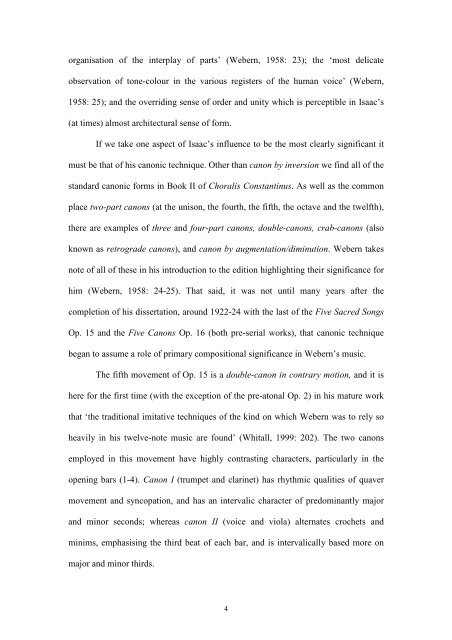
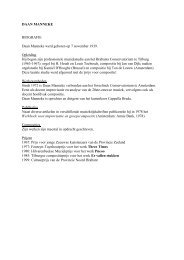
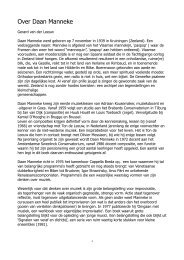
![Schubert, Winterreise: Einsamkeit [PDF] - bestmusicteacher.com](https://img.yumpu.com/21166489/1/190x135/schubert-winterreise-einsamkeit-pdf-bestmusicteachercom.jpg?quality=85)
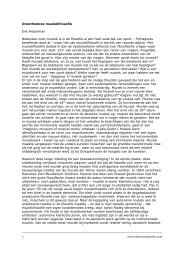
![Schubert, Winterreise: Die Nebensonnen [PDF] - Bestmusicteacher ...](https://img.yumpu.com/20295219/1/190x135/schubert-winterreise-die-nebensonnen-pdf-bestmusicteacher-.jpg?quality=85)
